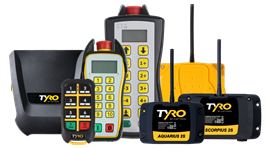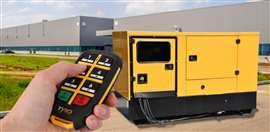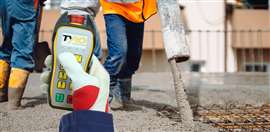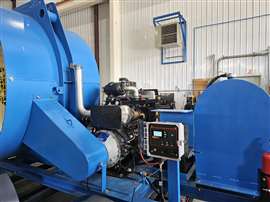Cattron helps humans, engine-powered machines work together
16 September 2024
Integration of brands such as DynaGen, Tyro expand company’s product catalog
 The portable fan units from Pauls Fan are used in underground mines and quarries. (Photo: Pauls Fan Co.)
The portable fan units from Pauls Fan are used in underground mines and quarries. (Photo: Pauls Fan Co.)
There have been many discussions about what a prolonged skilled labor shortage could mean for safety and productivity in mining, construction, farming – or any industry where humans and machines work alongside each other. Fortunately, technology exists to make it possible for everyone and everything to work together to help pick up the slack.
Cattron, a Warren, Ohio-based company long known for wireless remote control systems used in locomotives, cranes and other material handling applications, is prepared to help solve the staffing and productivity challenges that will arise when it’s hard to find good help.
Strategic acquisitions
To build upon its in-house expertise, Cattron acquired several companies that helped expand its product line. Thanks to the addition of brands such as DynaGen, CANplus, Tyro, Remtron and BWI Eagle, Cattron’s product portfolio now includes engine and generator control panels, cloud-based monitoring and control solutions – and it has the expertise to combine any of those options with wireless remote control systems for original equipment manufacturers (OEMs), engine distributors and end users.
The equipment industry has undergone a significant transformation since U.S. EPA Tier 4 Final engines arrived on the scene.
“After engines became more complex with the electronic controls needed to meet Tier 4 Final and Stage 5 emissions regulations, we’ve seen that customers have the desire to get more information from their engines,” said Shane Samson, business development manager, Engine & Mobile Equipment OEM, Cattron. “At the same time, there are a lot of mobile applications that need a higher level of automation, data collection and remote reporting so more can be done with fewer people.”
Cattron can help companies give that functionality to their equipment. While efficiency is important to the bottom line, safety for operator and bystander remains a primary driver for wireless remote control systems and for automating certain functions.
“If you have to operate the machine while you’re close to it – such as running a conveyor – you’re subjecting the operator to a potential safety risk if something goes wrong or if something they hadn’t anticipated changes in the environment they’re working in,” said Samson. “Doing that work at a distance offers comfort in that the operator gets a much wider field of view and it puts them in a much better position from a safety standpoint.”
 Tyro Remotes’ product line is now available in North America. (Photo: Cattron)
Tyro Remotes’ product line is now available in North America. (Photo: Cattron)
Better communication
To help improve communication with the engine, Cattron recently launched the CANplus CP500 engine control panel for small electronically or mechanically governed engines and the DynaGen 200 engine controller, designed for vehicle-mounted auxiliary engines and generator applications used in harsh environments.
“Something that continues to add value and differentiates Cattron from the competition is that we’re really a one-stop shop,” said Samson. “If a customer is looking to remotely control their equipment – and that’s very common in the mobile world – we can provide solutions. If they want integration into engine functions because some of the things they want to control are engine related, we have a whole product portfolio of on-engine controls.”
The compact DynaGen 200 engine controller is designed for manual and autostart operations on auxiliary engines and is suitable for dash mounting, CANbus integration and private labeling. Designed for equipment such as excavators, harvesters and vacuum trucks, it is equipped with six inputs and three outputs, J1939 and Modbus RS-485 message support and is compliant with U.S. EPA Tier 4 Final and Euro Stage V standards.
The CANplus CP500 panel is a plug-and-play version of the DynaGen 200 installed in a rugged housing equipped with vibration isolation mounts. It is designed for applications such as small pumps used in flood management.
The products share the same software and firmware, ensuring a consistent user experience across platforms, said the company, and they can integrate with Cattron’s Messenger BLE or Messenger Lite telemetry devices, powered by its RemoteIQ web-based portal, to enable remote monitoring and control capabilities.
“In some respects, a typical radio remote company that works with an OEM will see the engine controller as a black box and will work around it,” said Samson. “That isn’t our approach. We intimately understand the engine, its controller and the radios, and we can make them function in whatever way the customer wants.”
 The Tyro Musca 2S transmitter from Cattron. (Photo: Cattron)
The Tyro Musca 2S transmitter from Cattron. (Photo: Cattron)
Tyro arrives in North America
Cattron also recently announced that its Tyro 2S line of wireless remote control systems are now available in North America. Tyro Remotes’ products have been used in mobile equipment in Europe for more than two decades. Cattron acquired the Almelo, Netherlands-based control specialist during the summer of 2022.
The products are used to control a variety of diesel engines as well as electric and hydraulic motors, providing connectivity across a range of equipment.
“We are proud to offer U.S. and Canadian customers the same level of performance and reliability that European customers have appreciated from Tyro for years,” said Cattron CEO Ryan Wooten. “Tyro products bolster our global portfolio with a proven remote control solution for mobile equipment applications.”
The catalog includes transmitters (named Musca, Pyxis, Cetus and Fornax) and receivers (Aquarius, Auriga and Scorpius). The handheld transmitters use industrial-grade housings, while most receivers get durable, potted waterproof solid-state circuit boards within impact-resistant enclosures.
 The Tyro Pyxis 2S remote control system from Cattron. (Photo: Cattron)
The Tyro Pyxis 2S remote control system from Cattron. (Photo: Cattron)
The latest Musca 2S transmitter has large, tactile buttons so it can be operated with gloves, while its backlit keys and audible and haptic feedback improve usability in challenging conditions.
The Tyro 2S systems offer one-button pairing, allowing operators to quickly pair a new transmitter with the receiver, minimizing downtime. The company said this is beneficial in mobile equipment that is moved frequently. Models are available with an LCD screen to let operators scroll and toggle between multiple screens to control, monitor and adjust machinery settings. Integration with CANbus systems permit communication between the remote control and the equipment, while machine-to-machine (M2M) programing is also possible, said the company.
Tyro 2S products support 434 MHz for Europe, 915 MHz for North America and 2.4 GHz globally.
“With Tyro, there are a lot of unique capabilities just from the ability to customize the radio,” said Samson. “Out of the box, I can assign buttons to output momentary functions. There is a high level of flexibility there.”
 Thanks to Cattron and engine distributor W.W. Williams, Pauls Fan customers can choose to operate their engine-driven fans from inside the cab of a machine. (Photo: Cattron)
Thanks to Cattron and engine distributor W.W. Williams, Pauls Fan customers can choose to operate their engine-driven fans from inside the cab of a machine. (Photo: Cattron)
The latest and greatest fans
Pauls Fan Co. is an industrial fan manufacturer near Big Rock, which is located in a small triangle of western Virginia that’s bordered by Kentucky and West Virginia. The company was founded by Paul Elswick in 1958 to support local coal mines, and today it has customers throughout the United States with underground mines and quarries its largest market. It makes stationary axial and centrifugal fans for mine ventilation as well as portable engine-driven fans mounted on trailers or skids. The engine-driven models are used by miners in locations where electricity is not available. Each of the company’s fan models are custom-built with a significant portion of the components manufactured in-house.
“We’ve been building these fans for 15 years or better,” said Rages Matney, mining sales manager for Pauls Fan. “In 2018, we had to make some changes to our designs to accept and adapt to the new Tier 4 Final engines. Since then, we always search for a way to improve each of these fans to make them more efficient, more customizable and more user friendly.”
Today, the company builds portable fans in 6-ft. (Model 72) and 8-ft. (Model 96) diameters, and both use a Deutz Power Pack with a 2.9 L diesel engine rated 49 hp. The operating range of the fan is a maximum 2,600 rpm – which is what the engine puts out. With the pulley ratio, its fan blade speed is 900 rpm. Model 72 will put out around 140,000 cfm at zero pressure, while Model 96 will put out around 180,000 cfm at zero static pressure.
The fans originally used a manual PTO-type of clutch for the belt-driven fan, but customers wanted something more convenient. The engineering team at Pauls Fan spec’d an electromagnetic clutch from North American Clutch & Driveline Inc. (NACD) and wanted a way to connect it to the fan’s control panel. The fan company’s engine distributor had a solution: a DynaGen TE350 engine control panel and a Tyro Pyxis 2S remote control. The system not only engages and disengages the clutch but will also start the engine, ramp the fan up at incremental speeds and power it down.
“Now the operator won’t have to physically be right there within arm’s reach of the control box and the fan, pushing the buttons and engaging them by hand,” said Matney. “It allows the operator to be in a cab of a vehicle or anywhere within sight of the fan.
“The new fan’s already been a good little addition for us. Shortly after we got the prototype done and tested, I got a call from a customer in the Midwest that’s in a situation and needed a remote fan right then. It went right to work.”
The portable fans manufactured by Pauls Fan are primarily used in non-metal mines such as coal, stone or gypsum. They are employed to clear out the hanging smoke, fumes and dust after the rock face is drilled and blasted.
“They need to evacuate that area from all of the contaminants after the shot is fired so that they can go back to work,” said Matney, “so they use the air flow to basically sweep and clean the area after detonation.”
As the mine advances, the fan is moved to a new spot and the cycle repeats.
“Another application underground is that in some of the mines that go deeper, there’s less natural air movement, and they need a way of moving air throughout the mine,” said Matney. “They’ll use the fans as a set, where they’re spaced out in different locations to make sure air circulates throughout the mine.”
The latest models of engine-driven fans also get new bearing technology and other components to help ensure high efficiency and airflow performance, which the company said is vital for maintaining safe and healthy working conditions underground.
One in the pocket
Engine distributor W.W. Williams’ Clarksville, Ind., location supports customers of off-highway diesel engines and power generation equipment. It is the Deutz engine distributor for Pauls Fan Co., and Mike Wheatley calls on the manufacturer. The distributor has also worked with Cattron for years, and Wheatley said having its technology in his back pocket has been a great opportunity for customers.
“We’d been selling Pauls Fan Deutz diesels and when I brought up the remote control capabilities they were interested,” said Wheatley. “Shane and I went down there and we saw the new fan project they were working on. They told Shane what they wanted, and it only took him a couple of hours to program it. And they loved it. He was a hero.”
“A lot of customers talk about the simplicity of our products,” said Samson. “People can look at the panel and almost immediately understand what they need to do to run the machine, adjust the speed or whatever the case might be, and that same message was echoed by Rages at Pauls Fan. He was impressed that the DynaGen panel was so simple compared to the panel he was using previously.”
Wheatley and Samson visited another engine customer on the same trip. The OEM had recently received a request from a mining operation that wanted one of its machines converted to remote control.
“I just happened to have a Tyro Musca unit with me,” said Samson, “and after a couple of hours of reviewing the schematics, we were able to operate the machine just as they wanted. Now they’ve seen first-hand what the technology can do and so we’re working on some other opportunities with them, too.”
This article originally appeared in the September 2024 issue of Power Progress.
CONNECT WITH THE TEAM





